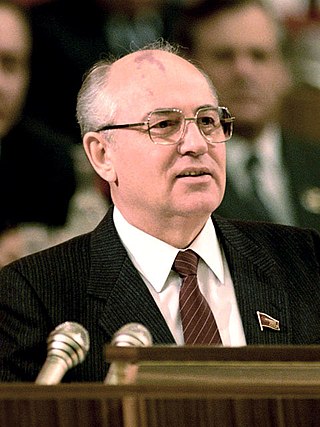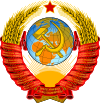
The Brezhnev Doctrine was a Soviet foreign policy that proclaimed that any threat to "socialist rule" in any state of the Soviet Bloc in Central and Eastern Europe was a threat to all of them, and therefore, it justified the intervention of fellow socialist states. It was proclaimed in order to justify the Soviet-led occupation of Czechoslovakia earlier in 1968, with the overthrow of the reformist government there. The references to "socialism" meant control by the communist parties which were loyal to the Kremlin. Soviet leader Mikhail Gorbachev repudiated the doctrine in the late 1980s, as the Kremlin accepted the peaceful overthrow of Soviet rule in all its satellite countries in Eastern Europe.
Glasnost is a concept relating to openness and transparency. It has several general and specific meanings, including a policy of maximum openness in the activities of state institutions and freedom of information and the inadmissibility of hushing up problems. In Russian the word 'гласность' has long been used to mean "openness" and "transparency". In the mid-1980s, it was popularised by Mikhail Gorbachev as a political slogan for increased government transparency in the Soviet Union within the framework of perestroika, and the calque of the word entered into English in the latter meaning.

Mikhail Sergeyevich Gorbachev was a Soviet and Russian politician who served as the last leader of the Soviet Union from 1985 to the country's dissolution in 1991. He served as General Secretary of the Communist Party of the Soviet Union from 1985 and additionally as head of state beginning in 1988, as Chairman of the Presidium of the Supreme Soviet from 1988 to 1989, Chairman of the Supreme Soviet from 1989 to 1990 and the President of the Soviet Union from 1990 to 1991. Ideologically, Gorbachev initially adhered to Marxism–Leninism but moved towards social democracy by the early 1990s. He was the first and only Soviet leader born after the country's foundation.

Perestroika was a political reform movement within the Communist Party of the Soviet Union (CPSU) during the late 1980s, widely associated with CPSU general secretary Mikhail Gorbachev and his glasnost policy reform. The literal meaning of perestroika is "restructuring", referring to the restructuring of the political and economic systems of the Soviet Union, in an attempt to end the Era of Stagnation.
The Sinatra Doctrine was a Soviet foreign policy under Mikhail Gorbachev for allowing member states of the Warsaw Pact to determine their own domestic affairs. The name humourously alluded to the song "My Way" popularized by Frank Sinatra—the Soviet Union was allowing these states to go their own way. Its implementation was part of Gorbachev's doctrine of new political thinking.

Neue Ostpolitik, or Ostpolitik for short, was the normalization of relations between the Federal Republic of Germany and Eastern Europe, particularly the German Democratic Republic beginning in 1969. Influenced by Egon Bahr, who proposed "change through rapprochement" in a 1963 speech at the Evangelische Akademie Tutzing, the policies were implemented beginning with Willy Brandt, fourth Chancellor of the FRG from 1969 to 1974, and winner of the 1971 Nobel Prize for Peace for his efforts to place this policy at the acme of the FRG.

German reunification was the process of re-establishing Germany as a single full sovereign state, which took place between 9 November 1989 and 15 March 1991. The "Unification Treaty" entered into force on 3 October 1990, dissolving the German Democratic Republic and integrating its recently re-established constituent federated states into the Federal Republic of Germany to form present-day Germany. This date has been chosen as the customary German Unity Day, and has thereafter been celebrated each year as a national holiday in Germany since 1991. As part of the reunification, East and West Berlin were also de facto united into a single city, which eventually became the capital of Germany.
The term "new world order" refers to a new period of history evidencing dramatic change in world political thought and the balance of power in international relations. Despite varied interpretations of this term, it is commonly associated with the notion of world governance.

The Treaty on the Final Settlement with Respect to Germany , more commonly referred to as the Two Plus Four Agreement , is an international agreement that allowed the reunification of Germany in October 1990. It was negotiated in 1990 between the 'two', the Federal Republic of Germany and the German Democratic Republic, in addition to the Four Powers which had occupied Germany at the end of World War II in Europe: France, the Soviet Union, the United Kingdom, and the United States. The treaty supplanted the 1945 Potsdam Agreement: in it, the Four Powers renounced all rights they had held with regard to Germany, allowing for its reunification as a fully sovereign state the following year. Additionally, the two German states agreed to reconfirm the existing border with Poland, accepting that German territory post-reunification would consist only of what was presently administered by West and East Germany—renouncing explicitly any possible claims to the former eastern territories of Germany including East Prussia, most of Silesia, as well as the eastern parts of Brandenburg and Pomerania.
Jimmie Lee Hoagland is a Pulitzer prize-winning American journalist. He is a contributing editor to The Washington Post, since 2010, previously serving as an associate editor, senior foreign correspondent, and columnist.

The time period of around 1985–1991 marked the final period of the Cold War. It was characterized by systemic reform within the Soviet Union, the easing of geopolitical tensions between the Soviet-led bloc and the United States-led bloc, the collapse of the Soviet Union's influence in Eastern Europe, and the dissolution of the Soviet Union in 1991.

The Malta Summit was a meeting between United States President George H. W. Bush and Soviet General Secretary Mikhail Gorbachev on December 2–3, 1989, just a few weeks after the fall of the Berlin Wall. It followed a meeting that included Ronald Reagan in New York in December 1988. During the summit, Bush and Gorbachev declared an end to the Cold War, although whether it was truly such is a matter of debate. News reports of the time referred to the Malta Summit as one of the most important since World War II, when British prime minister Winston Churchill, Soviet General Secretary Joseph Stalin and US President Franklin D. Roosevelt agreed on a post-war plan for Europe at the Yalta Conference.

Relations between the Soviet Union and the United States were fully established in 1933 as the succeeding bilateral ties to those between the Russian Empire and the United States, which lasted from 1776 until 1917; they were also the predecessor to the current bilateral ties between the Russian Federation and the United States that began in 1992 after the end of the Cold War. The relationship between the Soviet Union and the United States was largely defined by mistrust and tense hostility. The invasion of the Soviet Union by Germany as well as the attack on the U.S. Pacific Fleet at Pearl Harbor by Imperial Japan marked the Soviet and American entries into World War II on the side of the Allies in June and December 1941, respectively. As the Soviet–American alliance against the Axis came to an end following the Allied victory in 1945, the first signs of post-war mistrust and hostility began to immediately appear between the two countries, as the Soviet Union militarily occupied Eastern European countries and turned them into satellite states, forming the Eastern Bloc. These bilateral tensions escalated into the Cold War, a decades-long period of tense hostile relations with short phases of détente that ended after the collapse of the Soviet Union and emergence of the present-day Russian Federation at the end of 1991.

George H. W. Bush's tenure as the 41st president of the United States began with his inauguration on January 20, 1989, and ended on January 20, 1993. Bush, a Republican from Texas and the incumbent vice president for two terms under President Ronald Reagan, took office following his landslide victory over Democratic nominee Michael Dukakis in the 1988 presidential election. His presidency ended following his defeat in the 1992 presidential election to Democrat Bill Clinton, after one term in office. Bush was the father of the 43rd president, George W. Bush.
Ronald Dietrich Asmus was a United States diplomat and political analyst. As U.S. Deputy Assistant Secretary of State for European Affairs (1997–2000), he was instrumental in the expansion of NATO to include former members of the Eastern bloc and acted as a leading policy designer in the U.S.–Europe relations.
"Europe Whole and Free" is a concept in international relations that describes a Europe governed universally by concepts of liberal democracy espoused by the United States and the European Union.
George H. W. Bush, whose term as president lasted from 1989 until 1993, had extensive experience with US foreign policy. Unlike his predecessor, Ronald Reagan, he downplayed vision and emphasized caution and careful management. He had quietly disagreed with many of Reagan's foreign policy decisions and tried to build his own policies. His main foreign policy advisors were Secretaries of State James Baker, a longtime friend, and National Security Advisor Brent Scowcroft. Key geopolitical events that occurred during Bush's presidency were:
New political thinking was the doctrine put forth by Mikhail Gorbachev as part of his reforms of the Soviet Union. Its major elements were de-ideologization of international politics, abandoning the concept of class struggle, priority of universal human interests over the interests of any class, increasing interdependence of the world, and mutual security based on political rather than military instruments. The doctrine constituted a significant shift from the previous principles of the Soviet foreign politics.

The controversy in Russia regarding the legitimacy of eastward NATO expansion relates to the aftermath of the Revolutions of 1989, when the fall of Soviet-allied communist states to opposition parties brought European spheres of influence into question. US documents claim that agreement on non-expansion of NATO to Eastern Europe took place orally and the alliance violated it with its expansion while the leaders of the alliance claim that no such promise was made and that such a decision could only be made in writing. Soviet President Mikhail Gorbachev, who participated in the 1990 negotiations, subsequently spoke out about the existence of a "guarantee of non-expansion of NATO to the east" inconsistently, confirming its existence in some interviews and refuting in others. Among academic researchers, opinions on the existence or absence of a non-extension agreement also differ.

The Washington Summit of 1990, also known as the "Two Plus Four" talks, was an international summit in the history of the Cold War in which the United States and Germany gained the Soviet Union's support for the reunification of Germany by agreeing that NATO needed to be reformed. As part of this effort, US President George H. W. Bush called for a NATO summit to reform the organization and demonstrate NATO's willingness to present a different approach to the Soviet Union. As part of his efforts to improve relations between the United States and the Soviet Union, Bush proposed a bilateral summit in Washington to Soviet Union President Mikhail Gorbachev, in addition to the NATO summit. Gorbachev agreed to the proposal, which resulted in the Washington Summit of 1990.













